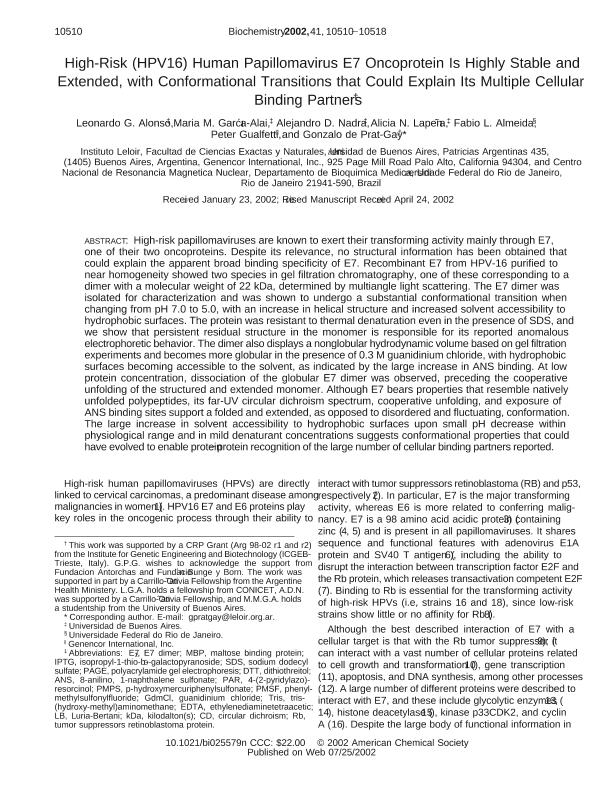Artículo
High-risk (HPV16) human papillomavirus E7 oncoprotein is highly stable and extended, with conformational transitions that could explain its multiple cellular binding partners
Alonso, Leonardo Gabriel ; García Alai, María M.; Nadra, Alejandro Daniel
; García Alai, María M.; Nadra, Alejandro Daniel ; Lapeña, Alicia M.; Almeida, Fabio L.; Gualfetti, Peter; de Prat Gay, Gonzalo
; Lapeña, Alicia M.; Almeida, Fabio L.; Gualfetti, Peter; de Prat Gay, Gonzalo
 ; García Alai, María M.; Nadra, Alejandro Daniel
; García Alai, María M.; Nadra, Alejandro Daniel ; Lapeña, Alicia M.; Almeida, Fabio L.; Gualfetti, Peter; de Prat Gay, Gonzalo
; Lapeña, Alicia M.; Almeida, Fabio L.; Gualfetti, Peter; de Prat Gay, Gonzalo
Fecha de publicación:
25/07/2002
Editorial:
American Chemical Society
Revista:
Biochemistry
ISSN:
0006-2960
e-ISSN:
1520-4995
Idioma:
Inglés
Tipo de recurso:
Artículo publicado
Clasificación temática:
Resumen
High-risk papillomaviruses are known to exert their transforming activity mainly through E7, one of their two oncoproteins. Despite its relevance, no structural information has been obtained that could explain the apparent broad binding specificity of E7. Recombinant E7 from HPV-16 purified to near homogeneity showed two species in gel filtration chromatography, one of these corresponding to a dimer with a molecular weight of 22 kDa, determined by multiangle light scattering. The E7 dimer was isolated for characterization and was shown to undergo a substantial conformational transition when changing from pH 7.0 to 5.0, with an increase in helical structure and increased solvent accessibility to hydrophobic surfaces. The protein was resistant to thermal denaturation even in the presence of SDS, and we show that persistent residual structure in the monomer is responsible for its reported anomalous electrophoretic behavior. The dimer also displays a nonglobular hydrodynamic volume based on gel filtration experiments and becomes more globular in the presence of 0.3 M guanidinium chloride, with hydrophobic surfaces becoming accessible to the solvent, as indicated by the large increase in ANS binding. At low protein concentration, dissociation of the globular E7 dimer was observed, preceding the cooperative unfolding of the structured and extended monomer. Although E7 bears properties that resemble natively unfolded polypeptides, its far-UV circular dichroism spectrum, cooperative unfolding, and exposure of ANS binding sites support a folded and extended, as opposed to disordered and fluctuating, conformation. The large increase in solvent accessibility to hydrophobic surfaces upon small pH decrease within physiological range and in mild denaturant concentrations suggests conformational properties that could have evolved to enable protein-protein recognition of the large number of cellular binding partners reported.
Palabras clave:
Papillomavirus
Archivos asociados
Licencia
Identificadores
Colecciones
Articulos(IIBBA)
Articulos de INST.DE INVEST.BIOQUIMICAS DE BS.AS(I)
Articulos de INST.DE INVEST.BIOQUIMICAS DE BS.AS(I)
Citación
Alonso, Leonardo Gabriel; García Alai, María M.; Nadra, Alejandro Daniel; Lapeña, Alicia M.; Almeida, Fabio L.; et al.; High-risk (HPV16) human papillomavirus E7 oncoprotein is highly stable and extended, with conformational transitions that could explain its multiple cellular binding partners; American Chemical Society; Biochemistry; 41; 33; 25-7-2002; 10510-10518
Compartir
Altmétricas



